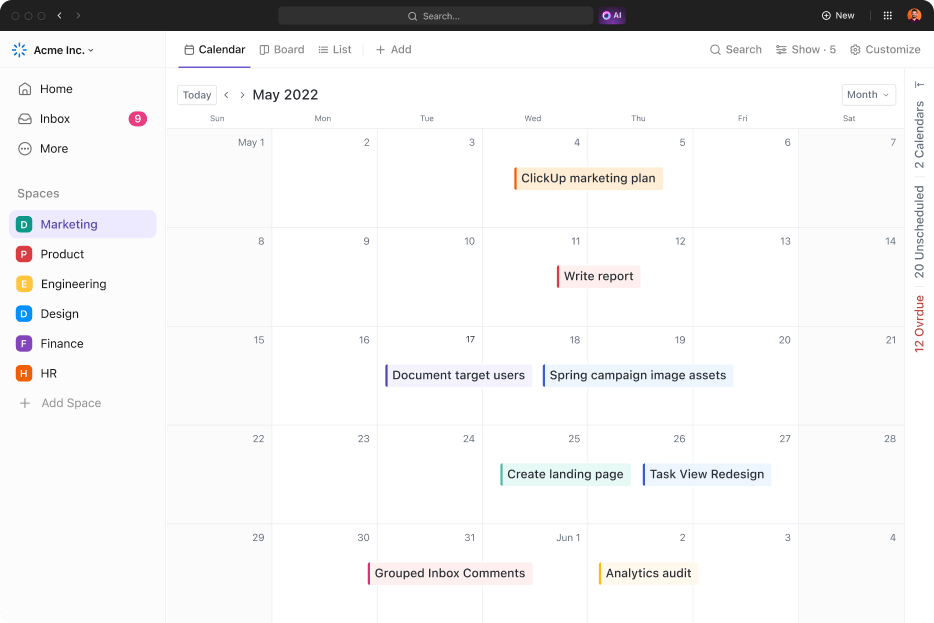هل تبدأ صباح يوم الاثنين بمهمة أن تكون منتجًا ولكنك تفقد زخمك في منتصف الطريق؟ نحن نتحدث عن أيام الأربعاء الحزينة، وأيام الخميس التي تختبر فيها قدراتك، وبحلول ظهيرة يوم الجمعة يكون قد حلّ ذلك الشعور الكئيب بإنهاء الأسبوع بشكل متواضع. 😪
إذا كانت الإجابة بنعم، فنحن نفهمك تماماً! لقد مررنا جميعًا بهذه الحالة، حيث نشعر بالتوتر والإحباط بسبب مستويات إنتاجيتنا المتواضعة. ومع ذلك، فإن المشكلة لا تكمن في مقدار الجهد الذي نبذله بل في مدى فعالية تخطيطنا للأمور مسبقاً.
في هذا الدليل، سنتطرق في هذا الدليل إلى التفاصيل الدقيقة لـ كيفية التخطيط لأسبوعك بطريقة تجعل مهامك المهمة منجزة وعطلة نهاية الأسبوع سعيدة. سنستكشف بعض الأمور التي تم اختبارها عبر الزمن عادات الإنتاجية لإكمال الأهداف طويلة وقصيرة الأجل - انظر كيف يمكنك الاستفادة منها لتحقيق التوازن بين أهدافك الشخصية وحياتك المهنية كالمحترفين!
فوائد وضع خطة عمل أسبوعية
فوائد التخطيط لأسبوعك بالكامل مسبقاً متعددة. أولاً، يمكنك تنظيم أولوياتك الأسبوعية وإعداد نفسك ذهنيًا للمهام التي تنتظرك. كما أن الشعور السائد بالهدف والتوجيه يحافظ على مستويات طاقتك عالية، مما يسهل عليك الالتزام بخطتك الأسبوعية. 😇
فيما يلي خمس فوائد أخرى لإعداد الخطط الأسبوعية:
- مستويات إنتاجية أفضل: نظرًا لأنك قد خططت لأهدافك قصيرة المدى مسبقًا، فمن المرجح أن تتمتع بأقصى مستويات الإنتاجية حيث تستمد الرضا من إنجاز كل مهمة
- تحسين الصحة النفسية: وفقًا لـتقرير عالمي عن العمل غير المخطط له، فإن العاملين غير المستعدين بشكل كافٍ من المرجح أن يواجهوا التوتر والقلق. تحافظ خطة العمل الأسبوعية على ثباتك وحركتك، مما يساعدك على الشعور بالثقة أثناء تبني عادات إنتاجية
- الحد الأدنى من الأعمال المتراكمة: إذا التزمت بخططك الأسبوعية، فسيتم فرز عملك في الوقت المحدد، ولن تضطر إلى رؤية المهام تتراكم
- عطلات نهاية الأسبوع الأكثر هدوءًا: إذا كنت تريد أن تقول نعم لـالتوازن بين العمل والحياة أو روتينًا مسائيًا مجددًا في عطلة نهاية أسبوع ممتعة، فعليك أن تخطط لأسبوعك مسبقًا!
- استجابة أفضل للأحداث غير المخطط لها: عندما تكون لديك فكرة معقولة عن مدى ازدحام جدول أعمالك الأسبوعي، يمكنك بسهولة إجراء تعديلات والاستجابة للأحداث والطلبات غير المخطط لها بمرونة أكبر
كيف يؤثر التخطيط المسبق على إنتاجيتك؟
إن التخطيط المسبق يزيل أي احتمال للشعور بالتعثر من خلال إخبارك بما تحتاج إلى القيام به بالضبط في أي وقت. كما أنه يزيل إمكانية شلل عبء العمل أو شلل التحليل إلى حد ما. هذا يمنعك من إنفاق الكثير من الوقت على أي مهمة معينة من خلال وضع حدود لمقدار الوقت الذي يجب أن تخصصه لأي نشاط معين.
مع هذا المستوى المرتفع من الوعي، لن تكون هناك حاجة في كثير من الأحيان لترتيب مهام العمل بشكل فعال كل يوم. بالإضافة إلى ذلك، من غير المرجح أن تنجرف مع المشتتات لأنك تعرف ما يتطلبه جدولك الزمني واستثمار الوقت اللازم لإكمال كل مهمة. كل هذا يزيد من إنتاجيتك في نهاية المطاف. ✅
كيفية التخطيط لمهامك الأسبوعية مسبقًا
يمكن تقسيم العملية الكاملة لتخطيط أسبوعك بفعالية إلى مرحلتين: المتطلبات المسبقة و عملية التخطيط الفعلي. سنلقي نظرة على هاتين المرحلتين، بالإضافة إلى بعض النصائح الإضافية التي يمكن أن تساعدك على تحقيق أقصى استفادة من أسبوعك المخطط له. لذا، اقرأ الأقسام العشرة التالية لإتقان العملية.
المرحلة 1: المتطلبات الأساسية
قبل أن تتمكن من البدء في التخطيط لأسبوعك التالي، عليك الاهتمام بأمرين: أ أداة التخطيط وأولوياتك الأسبوعية.
1. ضع نظاماً للتخطيط
سواء كنت تخطط للمهام الأسبوعية أو الأهداف السنوية، فأنت بحاجة إلى أداة إنتاجية مثل ClickUp للحصول على مخرجات راقية. تطبيقات الإنتاجية تحتوي على ميزات مثل تتبع الوقت والجدولة التي تجعل من السهل البدء في التخطيط عن قناعة والالتزام بأهدافنا بكل إخلاص. 🥰
يجب أن يتكون نظام التخطيط الأسبوعي المثالي من مخطط الروتين اليومي لإنشاء قوائم مهام مفصلة. بالإضافة إلى ذلك، يمكنك أيضًا البحث عن إدارة المهام و ميزات التقويم للتقويم المدمج جدولة العمل و تتبع تاريخ الاستحقاق .
ينتهي الأمر بالعديد من الناس إلى الحصول على تطبيقات متعددة للإنتاجية، وهو ما قد يمثل مشكلة لأن التنقل بين برامج متعددة لن يؤدي إلا إلى تعقيد يومك وإجراءات العمل.
إذا كنت تريد تطبيقًا للملاحظات والتقويم والمخطط اليومي مدمجًا في حل واحد، ففكر في تطبيق ClickUp. إنه من أفضل تطبيقات تتبع المشروع ومنصة إدارة مصممة لمساعدة الفرق والمهنيين على التحكم في وقتهم.
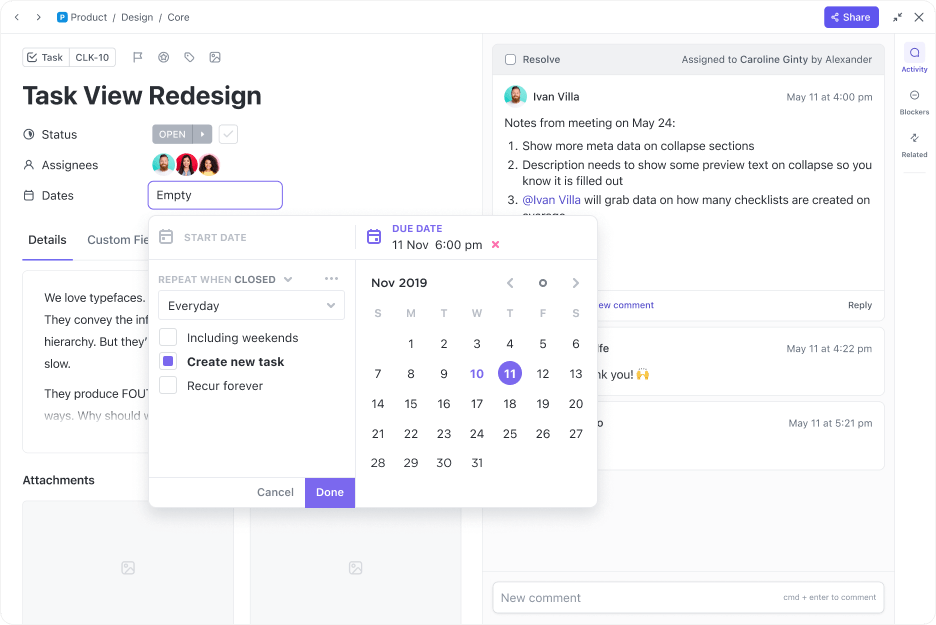
قم بتعيين تواريخ البدء والاستحقاق بسهولة وسرعة داخل المهمة أو استخدم الإعدادات الشرطية لتكرار التواريخ أو إنشاء مهمة جديدة بعد الانتهاء
2. فرز أولوياتك
سيساعدك وجود أولويات محددة بوضوح للأسبوع في الحفاظ على طاقتك للمهام الضرورية. فبدون فكرة واضحة عن أولوياتك، قد تواجه صعوبة في معرفة ما يأتي أولاً أو لاحقاً في جدولك الزمني أو ما يجب تركه أو تفويضه.
استخدم أولويات المهام في ClickUp 3.0 لتصنيف مهامك الأسبوعية التسليمات إلى أربعة مستويات أولوية مرمزة بالألوان: عاجلة، عالية، عالية، عادية، منخفضة.
يمكنك أيضًا الحصول على مفكرة رقمية داخل المنصة لتسجيل المهام ذات الأولوية القابلة للتتبع للأسبوع على هاتفك المحمول أو سطح المكتب. بهذه الطريقة، يمكنك إدارة الأسبوع، وليس العكس، بغض النظر عن مكان وجودك. 💃
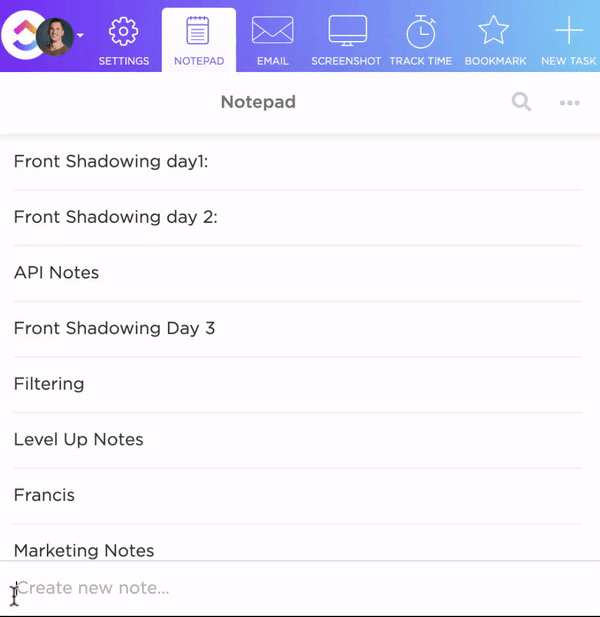
تسجيل الملاحظات وتحريرها بتنسيق غني وتحويلها إلى مهام قابلة للتتبع يمكن الوصول إليها من أي مكان في ClickUp Notepad
المرحلة 2: التخطيط
الآن بعد أن وضعت نظامك في مكانه ورتبت أولوياتك، يمكنك البدء في عملية التخطيط الفعلي. إليك كيفية القيام بذلك:
3. ضع قائمة مهامك بالترتيب
أولاً وقبل كل شيء، قم بتدوين كل ما تحتاج إلى القيام به في تطبيق الملاحظات الخاص بك (أو على الورق، إذا كان هذا ما تفضله). فكر في هذه الخطوة على أنها نوع من التفريغ الذهني - لا داعي للقلق بشأن أي ترتيب للأولويات أو الترتيب في الوقت الحالي. لا تفرط في التفكير في أي شيء، ودوّن كل ما تعتقد أنك بحاجة إلى إنجازه. 📝
إذا كنت تستخدم ClickUp، فإن القيام بهذا الجزء سهل - فقط قم بإنشاء مهام لكل ما تحتاج إلى إنجازه باستخدام مهام ClickUp . يمكنك حتى إرفاق مستندات أو ملفات وسائط أو أوصاف لكل مهمة لسهولة الوصول إليها. إذا كان لديك مشاريع متعددة، يمكنك إنشاء المهام الخاصة بكل منها داخل مجلدات مشاريع فردية لإبقائها مركزية.
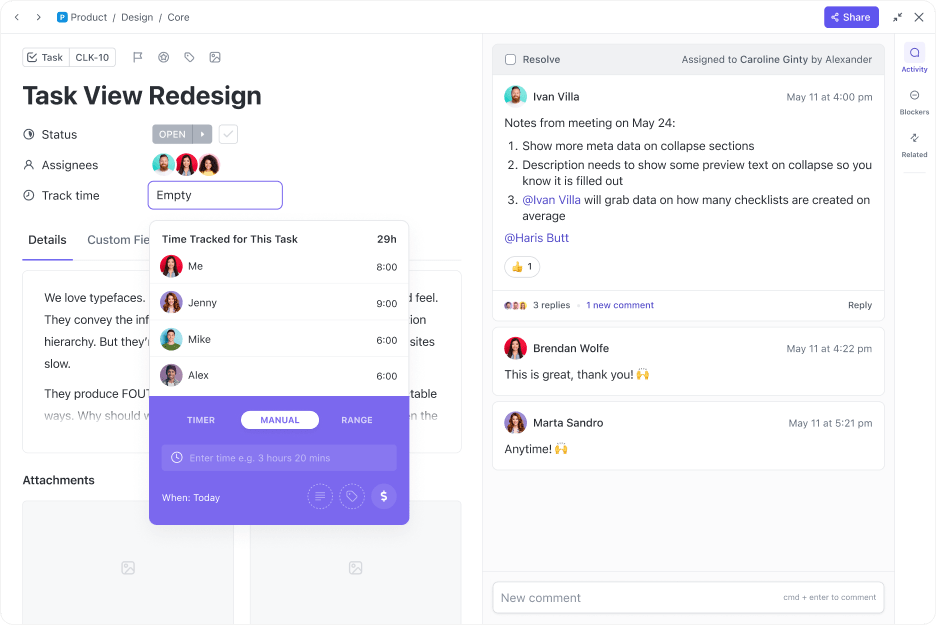
يمكن للمكلفين بتتبع الوقت الذي يقضونه في مهمة ما بسهولة، والتي تظهر مجتمعة في قائمة منسدلة بسيطة
يمكنك أيضًا تحديد تقديرات الوقت للمهام واستخدامها متتبع الوقت الأصلي ل ClickUp لإنهاء مهامك دون تأخير.
4. حظر الوقت للأحداث الحساسة للوقت
الآن، انظر الآن إلى قائمتك واعرف ما إذا كانت هناك أي أحداث أو أنشطة محددة بوقت محدد يجب القيام بها في تاريخ أو وقت محدد. قم بحظر الفترة الزمنية المحددة لها في التقويم الخاص بك حتى تعرف أنها فترات زمنية غير مرنة. إذا كنت تستخدم ClickUp، فيمكنك إنشاء مهمة وتعيين التاريخ والوقت المحددين لإنجازها. 📅
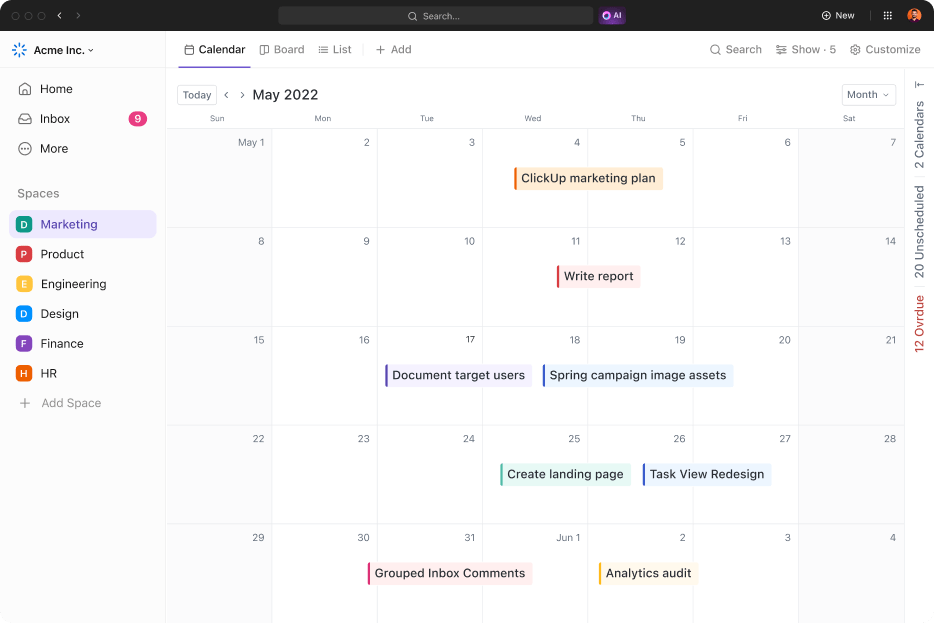
إدارة المشاريع وتنظيمها، وجدولة المهام عبر طريقة عرض التقويم المرنة للحفاظ على مزامنة الفرق
بمجرد قيامك بحظر المهام مع تحديد التاريخ والوقت، يمكن عرضها في لمحة سريعة على عرض تقويم ClickUp . هل تتطلع إلى الحفاظ على مرونة جدولك الزمني؟ ستساعدك واجهة السحب والإفلات في التقويم على ضبط جدولك الزمني بحركات بسيطة.
نصيحة إضافية: استخدم قالب التقويم الأسبوعي ClickUp لتخطيط مهامك للأسبوع القادم. تخطيطه الملون يجعل التنقل المرئي أسهل، مما يساعدك على تحديد وتعديل التعارضات أو التداخلات في أسرع وقت ممكن!
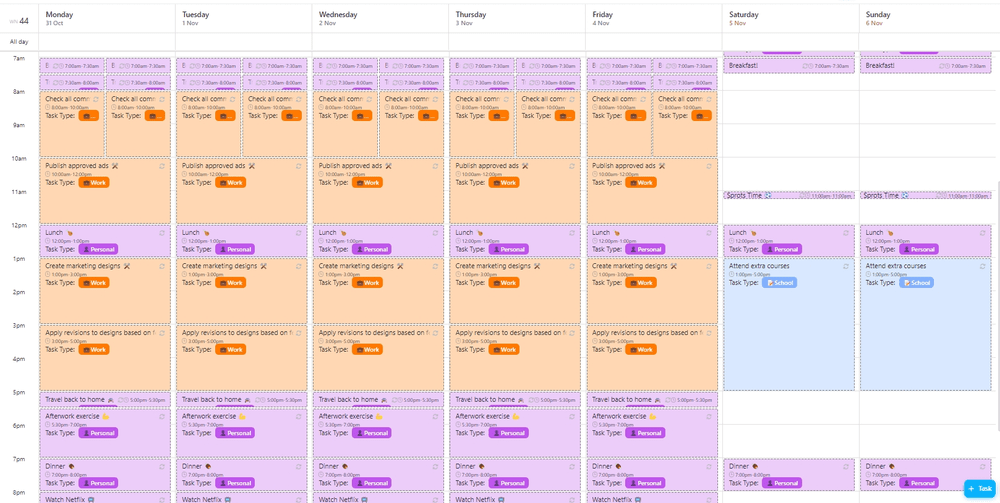
قم بتنظيم لقطة مثالية لأسبوعك مع قالب التقويم الأسبوعي ClickUp هذا
5. جدولة بقية الفعاليات والأنشطة الأسبوعية
بمجرد أن تقوم بحجز الوقت لكل تلك الأشياء التي تكون حساسة للوقت إلى حد كبير، فإن الخطوة التالية هي جدولة الأنشطة غير المحددة بوقت. وهنا يأتي دور فهم أولوياتك.
قم بجدولة الأشياء على أساس مكانها في جدول أعمالك قائمة الأولويات -يجب جدولة المهام ذات الأولوية العالية في وقت مبكر، بينما يجب جدولة المهام ذات الأولوية المنخفضة في أولويتك في وقت لاحق من الأسبوع.
إذا كنت تحب أن تخطط أسبوعك بشكل معقد لكل يوم، فمن الجيد استخدام قوالب المخطط اليومي . تأتي هذه القوالب مع قوائم محددة جيدًا للأنشطة اليومية وأمثلة على المهام المجدولة مسبقًا لإعطائك فكرة عن كيفية التخطيط بدقة.
6. جدولة أيام العطلة
أخيرًا، لا ترتكب خطأ الإفراط في الجدولة. من السهل أن نفرط في الطموح عندما نكون في حالة مزاجية مندفعة، مما يؤدي إلى إثقال أيامنا بالمهام. وهذا أمر غير بديهي وخطأ فادح!
نحن بشر والكثير من الأشياء التي نحتاج إلى القيام بها تتطلب التعامل مع بشر آخرين. والبشر لا يستطيعون العمل مثل الآلات - فقد يعانون من الإرهاق إذا بذلوا جهدًا كبيرًا. 😓
لذا، تأكد من تضمين بعض الوقت للراحة في خطتك الأسبوعية بين الحين والآخر. قم بتضمين روتين صباحي أو مسائي للتخلص من التوتر إذا اضطررت لذلك. احرص على تخصيص أيام يمكنك فيها الجلوس والاسترخاء أو القيام بأي شيء ترغب في القيام به.
وبالنسبة لكل مهمة تنطوي على بشر آخرين - مثل الاجتماعات والمكالمات - خصص 15-20 دقيقة إضافية على الوقت الذي تتوقع أن تستغرقه.
7. خطط في عطلات نهاية الأسبوع
لإعطاء نفسك السبق، خطط لأسبوعك بأكمله في أيام الأحد. عطلات نهاية الأسبوع مريحة، لذا يمكنك التفكير في الأمور بذهن صافٍ والتخطيط بشكل مثالي. بالإضافة إلى ذلك، يمنحك ذلك القدرة على البدء في إنجاز كل ما يجب القيام به اعتبارًا من يوم الاثنين نفسه، مما يمنحك بداية قوية لأسبوع عملك. 💪
نصائح أخرى
والآن بعد أن انتهينا من التخطيط الأساسي، إليك بعض النصائح الإضافية لتعزيز تركيزك الأسبوعي. الهدف هنا هو أن تكون أكثر مرونة عندما لا تسير الأمور وفقًا للخطة ولا تدع الانتكاسات البسيطة تدمر صحتك النفسية. 🫶
8. اترك المهام غير المهمة
قد تمر عليك بعض الأوقات التي يبدو فيها جدولك الأسبوعي مرهقًا بكل تلك المهام والاجتماعات والأنشطة الروتينية اليومية غير المهمة. كيف نعالج ذلك؟ ببساطة - اترك المهام غير المهمة وذات الأولوية المنخفضة للأسابيع اللاحقة. تذكّر النصيحة السادسة - لا داعي للإفراط في الجدولة!
إذا أعدت النظر حقاً في المهام، فمن المحتمل أن تجد شيئاً يمكن إسقاطه أو تفويضه للأسبوع القادم. هذا مهم بشكل خاص إذا كنت تخطط لمهام فريق كامل وليس لديك فكرة عن قدرة الجميع.
إذا كنت تتساءل عما إذا كنت قد بالغت في الجدولة أم لا، فإن عرض عبء العمل ClickUp يمكن أن ينقذك. فهو يصور لك عبء العمل الخاص بك وبفريقك على مدار الأيام ويمنحك رؤية سريعة لمن يفرط في أداء مهامه ومن لا يستغلها بشكل كافٍ. بهذه الطريقة، يصبح التفويض سهلاً. 😎
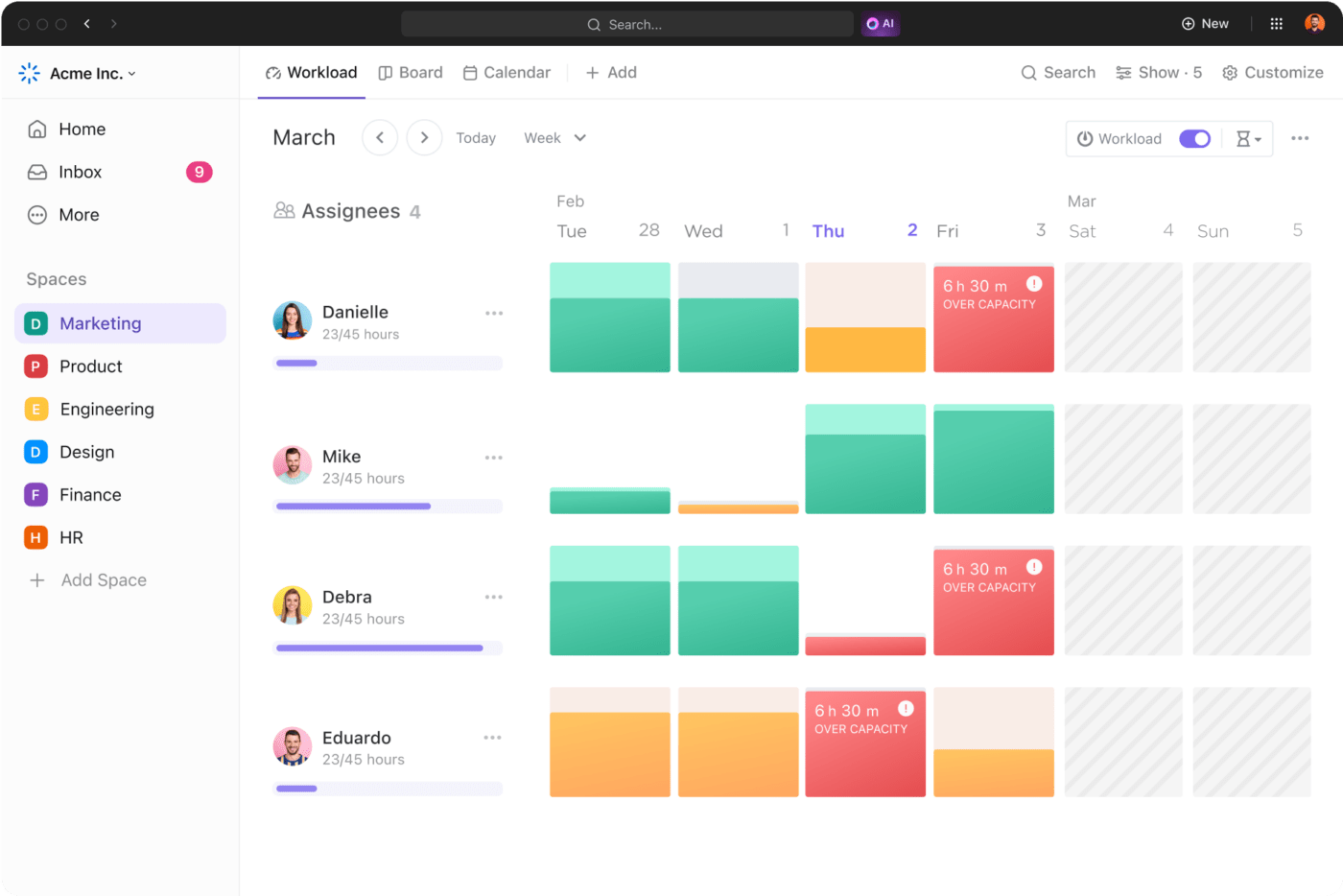
اطلع على أعباء عمل الفريق في لمحة سريعة لتفويض المهام أو إعادة تعيينها بشكل أفضل وفهم بسرعة من الذي لديه طاقة أقل أو أكثر من اللازم
9. تعلّم أن تقول لا
بمجرد أن تخطط لأسبوعك، يجب ألا تستقبل طلبات مرتجلة من أشخاص أو مواقف خارجة عن جدول أعمالك - ما لم تكن بالطبع حالة طارئة. وعندما نقول حالة طارئة، فهذا يعني بالفعل حالة طارئة خطيرة - أعز أصدقائي سيغضب إذا لم أذهب للتسوق معهم - ليس حالة طارئة. تعلم أن تقول لا إذا كنت تريد اتباع الجدول الزمني بمجرد وضعه. 🙅♂️
10. فكّر في جدولك الأسبوعي ونفّذ ما عليك تنفيذه للأسبوع القادم
أخيرًا، فكر في كيفية سير خطتك الأسبوعية. قد يكون هناك صعود وهبوط في الأسابيع القليلة الأولى بينما تدرب عقلك على المتابعة. إذا فشلت في شيء ما، استفد من الدرس للتخطيط بشكل أفضل للأسبوع القادم.
إذا كنت تحب التخطيط المدعوم بالبيانات، فابحث في مقدار الوقت الذي يستغرقه نشاط ما بالفعل، أو المهام أو الأنشطة التي يمكن تجميعها معًا، أو المهام التي يجب نقلها إلى وقت مبكر من الأسبوع.
يمكن أن تساعدك هذه الأفكار على تحسين إجراءات عملك وتصبح أكثر كفاءة كل يوم يمر. تذكر أن جدول العمل المثالي لا يُبنى في يوم واحد، بل يُبنى على مدار عدة أسابيع!
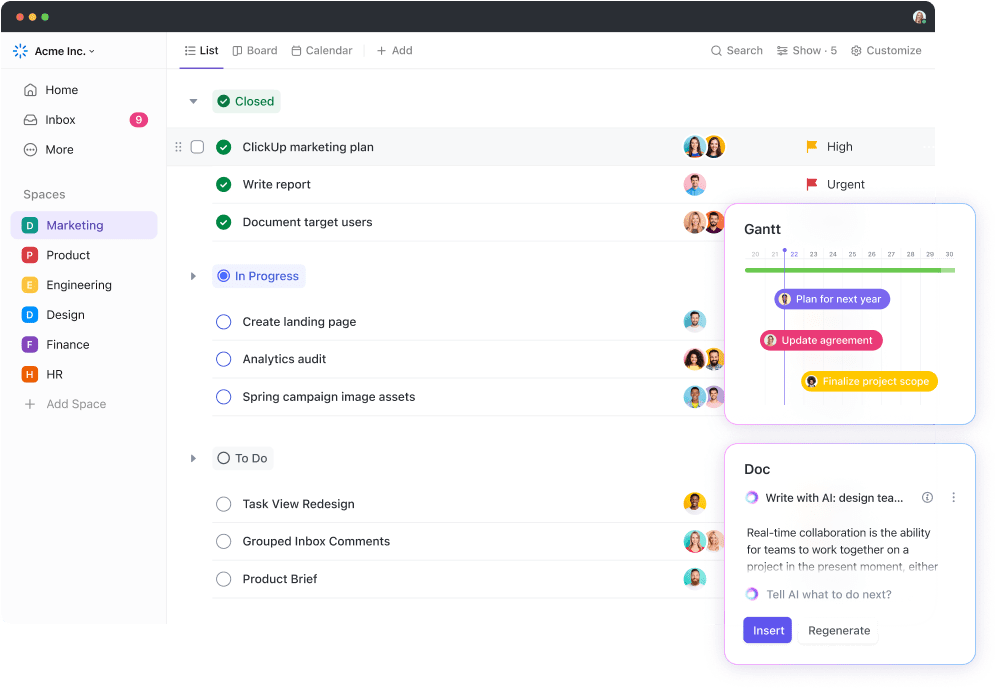
يمنحك ClickUp 3.0 القدرة على التحويل والتبديل بين طرق العرض المختلفة أثناء تحرير المهام مباشرةً باستخدام ClickUp AI
خطط لأسبوعك وحدد معايير الإنتاجية باستخدام ClickUp
إذا كنت تريد أيام إثنين هادفة وأيام أحد هادئة، استخدم منصة ClickUp المجانية لإدارة المشاريع كنظام تخطيط أسبوعي. سيساعدك ذلك على إدارة جميع مشاريعك في مكان واحد، مما يجعل من السهل بشكل كبير العمل مع أعضاء الفريق وفقًا لجدولك الزمني بفضل ميزات التعاون التي يوفرها.
إلى جانب ذلك، يحتوي ClickUp أيضًا على ميزات الأتمتة والذكاء الاصطناعي لمساعدتك على العصف الذهني بشكل أسرع، وإنشاء المحتوى، و توفير الوقت في المهام المتكررة. جرّب ClickUp وشاهد بنفسك كيف تزدهر إنتاجيتك الأسبوعية معه. 🌸
